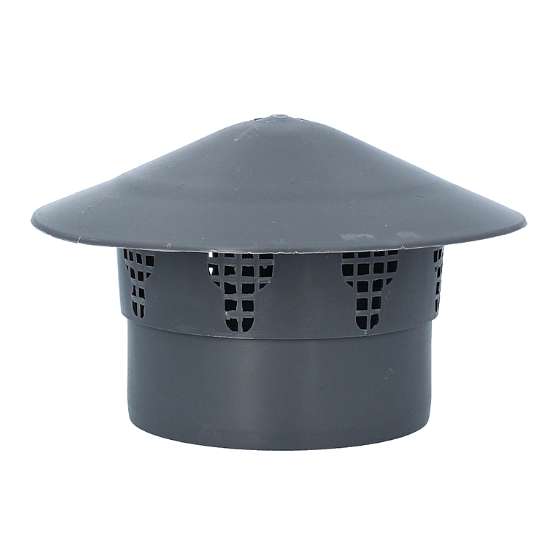Roof vent cap grey 50 mm
- Color: grey
- Cap diameter: 175 mm
- Height: 110 mm
- Size: 50 mm

Is an unpleasant smell something you would not want to appear in a room? This message might shock you - it can be prevented with one, simple piece of equipment - a roof vent cap. Protection against pests is a bonus.
Do you value high quality products? We do too! We offer you durable equipment which will last much longer than one season.
Millto roof vent cap guarantees high resistance to chemicals. It means it can withstand harmful substances such as sulphuric and nitric acids, as well as alkaline chemicals. They are ingredients of rainfalls which caused a chemical reaction.
Are you worried that changing weather conditions will reduce the roof vent's resistance? No need to! It can withstand any weather conditions, regardless of the season. Frost, rain or sun exposure - they are no problem at all.
Special construction of the roof vent cap is a guarantee of a more efficient plumbing system. It protects the vent from the rain, snow and other contamination carried by the strong wind.
We understand that the visual aspect might be equally important and the functionality of a building. That is why we offer you grey, brown and orange roof vent caps. This gives you a possibility to create a good-looking roof installation which will highlight the building's appearance. The simple and universal shape of the roof vent cap fits any building.
Every Millto roof vent cap has identical wall thickness - 1.8 mm. Choose the right roof vent cap by its diameter. We offer models such as 50 mm, 75 mm, 110 mm, 160 mm, 200 mm. Pick the one that fits your system!











A roof vent cap is the upper part of a construction called drain-waste vent. It’s the ending piece of a plumbing vent.To work properly, a roof vent cap needs to be installed above the rooftop of a building. There are certain requirements that a plumbing vent should meet - for instance for the size. The size of a roof vent should be equal to the plumbing vent opening diameter. The roof vent cap should be larger, so that it can fit the vent pipe.
A roof of a building is a strategic spot, prone to various types of dangers. It is mostly vulnerable to weather conditions due to seasonal weather changes. Those are, for instance, heavy rainfalls, snowfalls and windstorms. If there was no roof vent and roof vent cap, the sewage system and the plumbing vent would be exposed to those factors. Furthermore, the wind carries various objects - leaves, branches and other elements. If the plumbing vent was not protected, it could get clogged - which in the long run requires costly repairs. A roof vent cap protects the system from any unwanted elements.
Birds and rodents are also a common problem. A roof vent cap is perfect for such situations, as it protects the system of a building from unexpected pests.
A roof vent cap mostly protects home interiors. It stops any unpleasant smells from sewer tracts and improves the sewer drainage.
The processes in the sewer systems are the cause of unpleasant smelling gases. A roof vent prevents them from spreading further to the rooms in the building. It also serves another function. A roof vent allows the air to enter the plumbing system, thanks to which the waste is removed more efficiently.
There are certain guidelines stating how a roof vent cap should look like. They concern both the location of the roof vent, as well as its size. The height is the most important issue in this matter. It concerns the aforementioned snowfalls. The vent cap should be tall enough, so that it is situated above the layer of snow, allowing the airflow.
Roof vent caps cannot be located by an air intake vent or a vent outlet on the roof. What is more, it cannot be installed by windows and doors either. The general guidelines clearly state the minimal distance that should be kept from those spots - 4 meters.
Plumbing vent must not be connected with chimney or air vents of a building.
Roof vents are considered a far better choice than air admittance valves. Although the latter seem a simpler solution as they can be installed inside a building instead of its roof, they have some serious disadvantages.
A well constructed plumbing ventilation is based mostly on a two-way air exchange - removal of gases and pumping fresh air into the system so that the waste is removed efficiently. The air admittance valves can bleed the system, but they cannot resupply the fresh air to the system. For this reason a roof vent is a far better solution.